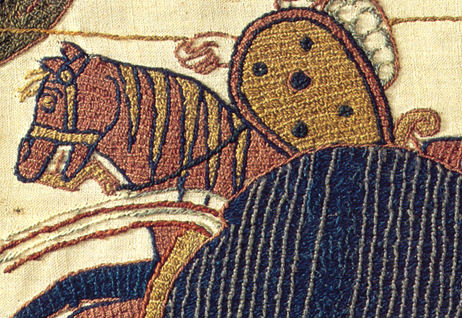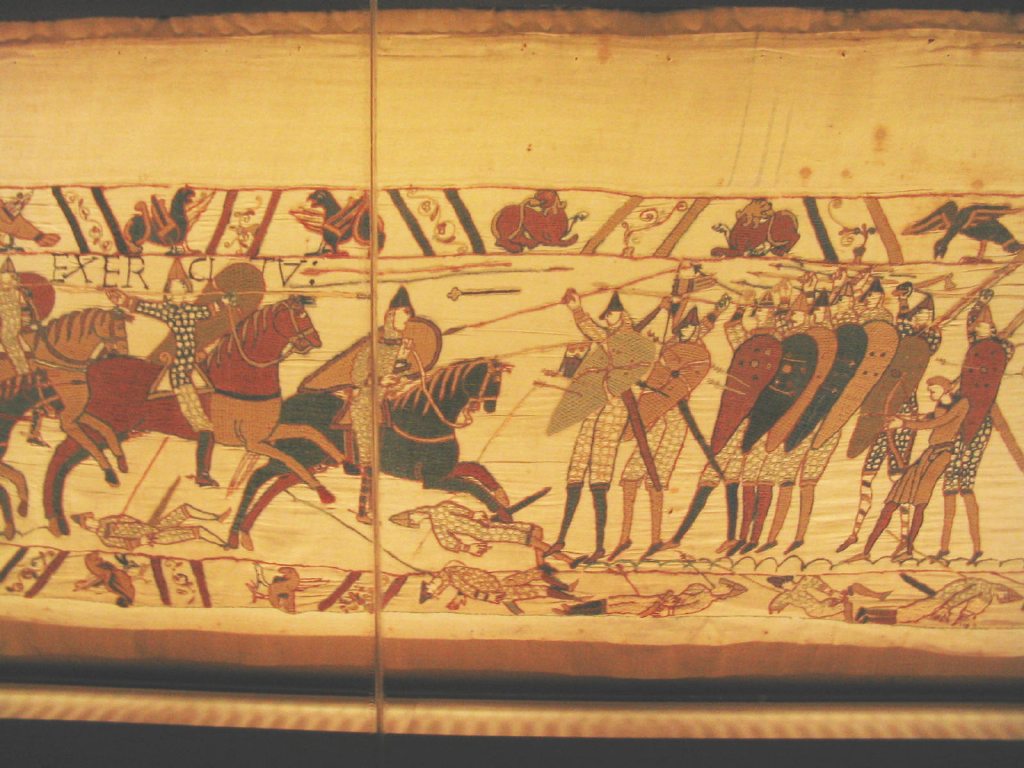Nic teaches historic sword fighting techniques. He’s been the technical consultant for a number of movies. The swords these fighters used were real weapons – not the blunted wooden swords used by the SCA. Most were replicas of ancient swords, but a couple were actual weapons from their time period, all beautifully maintained. Well, as well as possible. Nic show us black marks on one blade and commented that there’s only one thing that can corrode a sword like that. You guessed it. Nic commented there’s an irony in the fact that the only thing that can damage a sword is the one thing it’s designed to seek.
The first group to fight represented the Viking period, from about 800 to 1100 AD (later in the North.) Saxons, he said, would have used similar weapons and techniques. Most of our information on how Vikings fought comes from the Norse and Icelandic sagas.
Fighters of that period were well armed. They usually carried a round shield, a two-edged sword, a saex (a foot-long knife with a long triangular blade —the word “Saxon” comes from it), and often a fighting axe. They would wear a helmet and either armor constructed of leather or, if they could afford it, chain mail running to their knees. Altogether, their equipment could weigh has much as 35 kilos, about 80 pounds.
There’s no evidence that swordsmen of that period wore gloves, by the way. Even the fighters in the Bayeaux Tapestry, which depicts William the Conqueror’s 1066 invasion of English, had no gloves.
This picture from the Bayeaux Tapastry, by the way,
alos shows the knight carrying a heater as his shield.
What our fighters were wearing wasn't much different from the famous
helmet from the Sutton Hoo burial pictured above.
In fact, as they started to fight, fear was a good deal of the swordsmen’s strategy. There was a lot of posturing, posing and making of noise. Nic said that often the winner of a battle was determined by who stepped back first.
The shield was not only an important part of the fighter’s defense. It was part of the offense, as well. It could be used to push an opponent or to thrust his weapon aside.
Ideally, the shield should cover the fighter from his nipple to his knees, but the bigger a shield gets, the more it is vulnerable to being pulled by the wind. Shields were made of lightweight linden wood or a laminate of linden and oak, which combined lightness with strength. Some had steel bands on the face. They had straps on the back that the fighter slid his arm through. Most shields from that period were round, but heaters were also used.
Anyone who’s read Bernard Cornwell’s King Alfred series knows of the formidability of a shield wall. Nic had the fighters demonstrate a shield wall for us and it was easy to see why opposing one would have been such a challenge. As the fighters stood shoulder to shoulder, their overlapping shields were locked to each other by tucking the shield’s right edge between the next soldier’s shield and his left arm. This created a virtually impenetrable wall across the army’s front. Further, two or more fighters so locked together could maneuver as a unit, providing a strong, wide front that would protect the weaker fighter.
Saxon defenders making a shield wall, from the Bayeaux Tapestry.
The shield wall is on the right.
Here’s where a further Saxon/Viking weapon came in handy: the long axe. This is nothing more than an axe mounted on a handle as tall as a man. It gave its carrier the advantage of distance. It could be used to snake a shield away from a swordsman, making him vulnerable to the axe blow that followed.
Generally, though, Saxon/Viking combat was very close range. And individual encounters, contrary to what we read about in novels, didn’t last long. The demo fights we saw moved fast. One or two blows, that was it.
Nic said the average encounter – if one of the fighters didn’t back off immediately – usually lasted no more than 20 seconds, unless the combatants were evenly matched and extremely good. (Think of a battle as a series of encounters.) So when the sagas talk about a fight such as a holmgang – a ritualized fight settling a dispute between two men -- lasting for hours, they are playing up the skill of the two men.
How did a person get killed? Well, weapons from that period were designed to cut, rather than pierce. But unless, you succumbed to a blow in the face (King Harold Godwinson died at Hastings from an arrow in the eye) or losing a leg, you were not likely to die from a cut. Chain mail was good defense against the sharp edge of a sword. The power behind the blow, however, would crush the mail into you, cracking bones and creating internal injuries. That’s a lot harder for primitive medicine to treat than an open wound.
Next blog post: sword fighting in the age of plate armor.



This is great, Vicki! I would really love to have you read my forthcoming book The Comet, which features The Battle of Hastings. You can tell me everything I did wrong (WAH!).
ReplyDeleteWould love to read it, Miriam. But I'm no expert in battle history. What I have found is really interesting is looking at the Bayeaux Tapestry really close. It gives all sorts of clue to how things were done (if you ignore the flat perspective and look at the details.)
ReplyDeleteExcellent post, Vicky! Wonderful detail. One other thing about battles they don't tend to make much of in the movies: if you fell down, you stayed down. Trampeling was common. Fun, fun, fun! LOL
ReplyDeleteMy Battle of Camlann gets pretty grim. I noticed yours were that way, too. I think the other thing you have to take into account is the effect of the army churning up the field of battle. Despite the huge amount of liberty it took with history, I love the way the Rome TV series depicted the dust kicked up by the confronting armies in the Battle of Phillippi. You could barely see what was coming at you.
ReplyDeleteOne of the things you have to remember about the Middle Ages, though, is that most battles were small affairs, fifty combattants or less on each side. Just one local lord's "army" against his neighbor. Also, medieval accounts tend to exaggerate because they always had a secondary motive to recounting the information, such as making their overlord look good or criticizing a state of affairs.